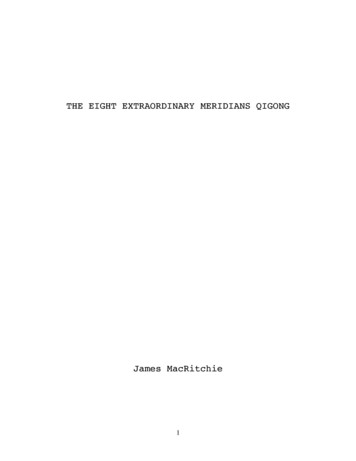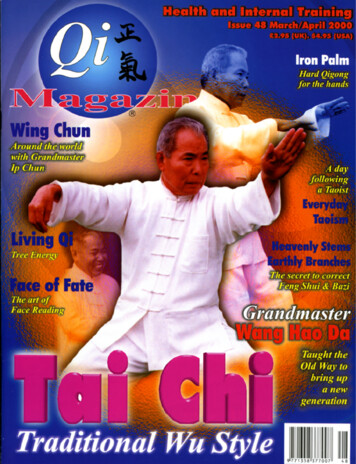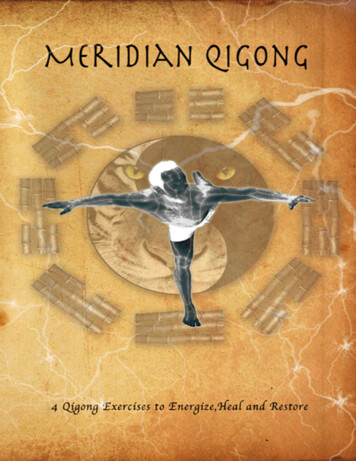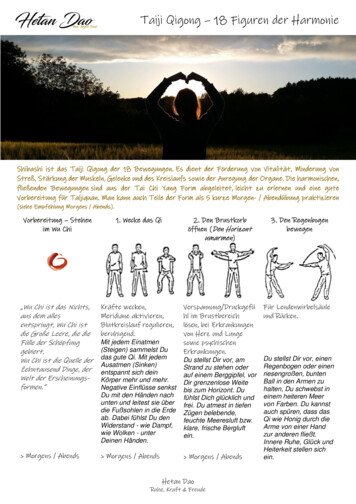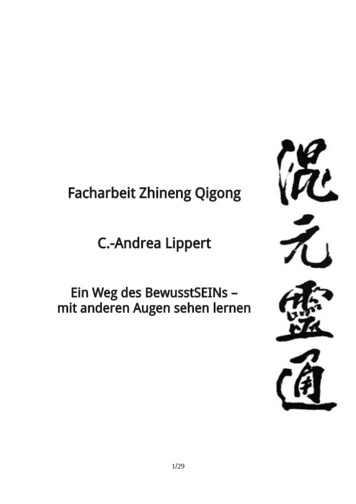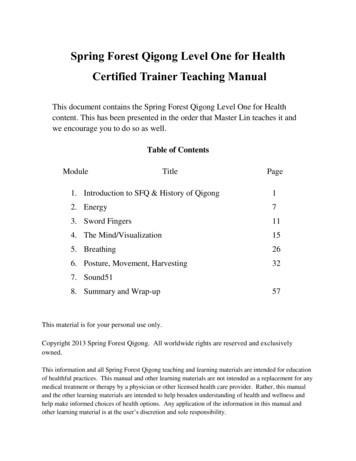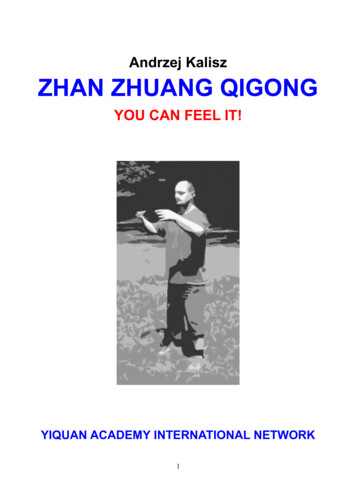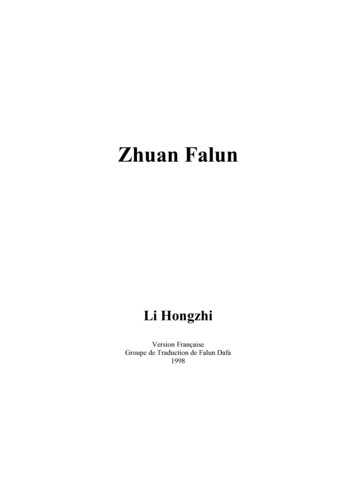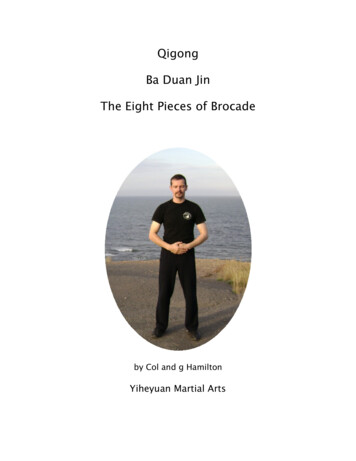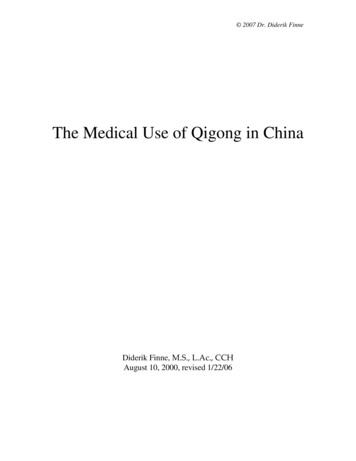
Transcription
2007 Dr. Diderik FinneThe Medical Use of Qigong in ChinaDiderik Finne, M.S., L.Ac., CCHAugust 10, 2000, revised 1/22/06
IntroductionHuaxia Zhineng Qigong Clinic & Training Center lies on the northeast coast of China, five hoursby train from Beijing. The Center houses over 3,000 patients and a staff of 600, including 26Western trained doctors. Many patients—called “students” at the Center—come diagnosed asincurable or terminally ill by Western trained doctors. Yet in the period 1988-95, of the 130,000students who attended the Center, 95% recovered.1The Center is the only hospital in the world that relies exclusively on a form of therapy called“qigong.” 2 This type of therapy involves a series of gentle movements designed to stimulate theflow of energy, or “qi,” through the body.From a Western perspective, the Center’s success rate is both remarkable and puzzling. Has theCenter discovered a new form of medicine? Or can the results be due to a form of faith healingwith a few exercises thrown in?Taber’s Medical Dictionary defines “faith healing” ashealing accomplished by supplication to a divine being or power without medicalor chemical aid. Although this area is open to fraudulent practice, the medicalcommunity cannot completely ignore the psychosomatic aspects of illness thatmay be affected in this manner.To learn more about the Center and answer the question of faith healing, I studied over onehundred interviews with former and current students of the Center.3 From these interviewscertain themes and facts emerged, which will be discussed in the following sections.About the authorDr. Diderik Finne is a Doctor of Acupuncture and a Certified ClassicalHomeopath. He is a graduate of Yale and the Pacific College of OrientalMedicine. He has been in private practice in New York City since 1997. Forcopies of this paper and other works by Dr. Finne, goto:diderikfinne@mindspring.com.1The 95% breaks down as follows: 42% noticeable improvement; 38% great improvement, withnear disappearance of symptoms; 15% complete cure. A total of 180 different diseases weretreated. All cases are documented with M.D. diagnosis and relevant test results.2The type of qigong practiced at the center is called “Zhineng Qigong”, as will be discussedpresently. In America, Zhineng Qigong has been renamed “Chi Lel”, presumably for ease ofpronunciation. In this paper, the term “Zhineng Qigong” is used throughout, to avoid confusion.Note that the Chinese word “qi” is pronounced “chee”.3as published by Luke Chan in 101 Miracles of Natural Healing, (Cincinnati: Benefactor Press,1996). Available on-line from www.chilel.com-1-
The Road To HealingAn Open MindThe first step for a student of the Center is the decision to try something out of the ordinary.Qigong therapy is unconventional, even by Chinese standards. “When a friend suggested we tryZhineng Qigong,” says Jing Shan, a man of 46, “we were in no mood to listen. If all theseprestigious hospitals with all their experts couldn’t cure our son, what could Zhineng Qigong do?I thanked our friend, but dismissed his idea as wishful thinking and an attempt to comfort us.”Jing’s son suffered from a benign upper lip tumor, which had grown to the point that it nearlyblocked his nose. The location of the tumor made surgery impossible. Doctors predicted the boyhad six months to live.“My friend, who was a Zhineng Qigong practitioner, kept on encouraging me to take the selfhealing art, saying, ‘What if Zhineng Qigong works? You owe it to your son to try it.’ Myfriend’s sincerity and unwavering belief in Zhineng Qigong gradually softened my heart andfinally dispelled any last hope I had in modern medication. Embracing Zhineng Qigong as theonly hope of curing my son’s condition, I brought him to the Center.”After twenty four days of practicing qigong at the Center, the boy was able to stop the tumor’sgrowth, and it even started to shrink. In the next few weeks it disappeared altogether.Yu Tian-Ming, 40, a former electrician who was accidentally electrocuted, came to the Center “adeeply skeptical person.” He remembers: “When I saw Lao-shi [theCenter’s director] helping people to walk, talk, and see, I dismissed it asmass hysteria. When people talked about their miraculous recoveries, Ithought they were either exaggerating or that their recoveries could havehappened anywhere.”Yu suffered from a feeling that he was always half-asleep, in a twilightstate of consciousness. Also, his knees were so stiff that walking wasdifficult, and his throat hurt each time he swallowed food.At the Center, Yu completely recovered his health. Nevertheless, heremained skeptical. “I don’t know exactly why, but somehow I didn’tbelieve my recovery was due to qi. Probably in my subconscious, I wassuspicious that others could have manipulated me like a fool. So I wenthome, knowing I had been cured, but nonetheless a doubter.”Yu Tian MingYu recounts how he gradually changed his mind:When people found out that I had been in the Center, they asked me to teachthem Zhineng Qigong. Well, it was no big deal for me to teach them in the park.One day someone asked me to emit qi to him in order to facilitate his healing,and when I did, he claimed that he was cured. I dismissed it as a student beingpolite. However, as I performed more qi healings, people kept telling me thesame thing.Without trying, I became a well-known healer in my area. Then one day arelative came to me requesting that I perform a healing on him. But I refused,-2-
because I am not a doctor and I didn’t want to bear any responsibility if he died.‘But the doctors have already sentenced me to death! Please help me,’ hepleaded, with his family at his side.I finally agreed to try, but told his family not to blame me if he died, adding, ‘Iam treating a dead horse as if it were alive.’ After a week of qi treatment, thepatient became more spirited and could sleep well. However, when he laterreacted to qi by developing a high fever and having frequent bowel movements, Ibecame worried. Immediately, I sent him to the Center, where he recovered amonth later.After this event, I was totally convinced of the existence of qi and its power, andI have been an ardent supporter of Lao-shi ever since.The MethodThe practice of qigong in China is perhaps 5,000 years old. Traditionally, it has been used tocultivate health, spiritual growth and longevity, somewhat like yoga. There are no references inthe classical medical texts to curing disease with qigong.Until the 1980’s, the practice of qigong was a closely guardedsecret within certain families and religious institutions, all ofwhich had their own style or form. Dr. Pang Ming, a qigonggrandmaster and physician trained in both Western and Chinesemedicine, pioneered the use of qigong for healing and graduallysynthesized Zhineng Qigong from his knowledge of variousforms and medical principles.According to students, Zhineng Qigong is best suited for healing.Zhou Fu-Chin, a woman of 58, notes: “I had tried other types ofqigong before and they didn’t work for me.” At the Center shecured herself of heart palpitation, severe headaches, an ovariantumor and a tendency to faint while walking.Dr. Pang MingZhang Chang-Rong, M.D., a woman of 64, comments: “I learned many types of qigong. Idecided to give up all other forms of exercise, however, to practice Zhineng Qigong exclusively.”Dr. Zhang was chief internist at a major hospital before she retired due to coronary disease,chronic bronchitis and rheumatoid arthritis. “Since I worked in a hospital, I had free access to allthe drugs I needed,” she says. After her retirement, she practiced Zhineng Qigong with a localgroup. “Eventually all my illnesses left me, and I didn’t need to take medication anymore. Ibecame so energetic that I wanted to go back to work.”Of what, exactly, does Zhineng Qigong consist? The most basic form involves standing with feettogether and moving one’s arms through a series of slow, gentle movements. From abiomechanical viewpoint, the muscles of the neck and shoulders are gradually warmed up andloosened, as well as those of the lower back, two areas where tension accumulates in most people.There is also a mental component. At the beginning of the form, students are told to imagine-3-
themselves merging into each of the four directions, and throughout the various movements onevisualizes either “the blue sky” or “deep inside” one’s body.Though it is not possible to analyze Zhineng Qigong in Western terms (of cause and effect), onecan distinguish some salient characteristics: the basic form takes only a few hours to learn—as opposed to years for certain other types ofqigongeven small portions of the routine may be effective in promoting healththere is no religion involvedthe movements are circular and evenly balanced between opening and closingZhineng Qigong also encompasses certain stand-alone exercises that can be practiced anytime,anywhere. To get a flavor of the form, two exercises are described below:Wall SquattingStand with feet together about a foot away from a smooth wall.Relax your shoulders and let your arms dangle. Slowly bend yourknees, keeping your heels on the ground and looking straightahead. Slowly drop down as far as you can. Try to curl your backone vertebra at a time. (If you get your wrists below your kneesyou’re doing great!) Smoothly reverse and come back up. Repeatup to 100 times.La ChiImagine you are holding a weightless grapefruit, with yourfingers and palms almost touching. Close your eyes and slowlypull your hands apart, as if you were pulling apart a soap bubble.When your hands are shoulder-width apart, reverse the process,bringing your hands together as if against the resistance of the air,until your palms and fingers almost touch.During the opening movement, visualize a fleecy cloud unraveling wisp by wispinto a blue sky. During the closing movement, picture the blue sky withinyourself. This visualization can also be used for the two phases of the wall squatas well.Liu Xing-Ceng, a young man of 21, was deaf. His case history does not specify the type ofdeafness, but presumably it was sensorineural. He tried many treatments, including electricallycharged acupuncture needles inserted in the ears. One day his high school teacher taught him LaChi, and Liu practiced it as much as four hours a day. After fourteen days he felt pain in his ears,but he nevertheless persevered. Several weeks later his hearing improved significantly.Liu’s story illustrates the power of a single qigong exercise. There is a curious twist to his story,however. Liu’s classmates made fun of his La Chi practice, and he quit. Subsequently, hishearing deteriorated again. A year later, Liu’s parents sent him to the Center, where hecompletely recovered his hearing.-4-
Another student, Jing Shan, introduced in An Open Mind, practiced wall squatting with his sonfor many hours at a time. His son’s record for consecutive wall squats was 700. Jing himself did1,200. They both experienced dramatic improvements in health within 24 days.On a personal note, I have tried Wall Squatting and La Chi myself. To do the Wall Squat, Isometimes “cheat” by standing on a slight forward incline. Also, I use an imaginary wall, so thatI can extend my arms in front of me. Despite these deviations from pure form, I have felt atingling warmth travel up my spine at times. My chronic lumbar pain is somewhat better,although it is difficult to quantify, or to say how much is due to the Wall Squatting. The bottomline, however, is that I continue to practice Wall Squatting every day; somehow my body wantsit, regardless of how tired or lazy I may feel. My personal record for wall squats is five in a row.The experience of La Chi is more subtle and difficult to describe. It seems conducive to a state ofrelaxed awareness. It is particularly useful for sitting through long meetings and lectures.DeterminationA man who does 1,200 wall squats in a row to cure himself is not your average patient, even byChinese standards. Throughout the case histories, the determination and self-discipline of thesepatients is apparent.Ren Jing Xiang, a man of 42, suffered from heart problems for four years. He was scheduled foropen heart surgery in 1993, but the surgeon advised him towait until his heart failed completely. He came to theCenter on the off-chance that it might help. “One night as Iwas practicing holding my hands up,” he relates, “I toldmyself that to heal my illness I must have determination.”He felt some heart palpitations, but continued to keep hishands up. “After some time, I felt my heartbeat quiet down.Worried at first, I told myself that I would rather die than putmy hands down. As time went on, I felt changes in my heartas its beats and sounds returned to normal. When the cockcrowed the next morning, I sensed my heart had completelyRen Jing Xiangrecovered.” Eight and a half hours had passed.An EKG test confirmed Ren’s intuition: his heart had returned to normal, and it was still normalas of 1995.Such triumphs of will are not limited to men. Yu Xun-Lan, a woman of63, had high blood pressure, coronary disease, gallstones, kidney problems,and rheumatoid arthritis. “Other than my lungs, all my body functionswere bad,” she says. “Every specialist in the hospital knew me by name, asI regularly took turns seeing them. After being in and out of the hospitalfor about ten years, I suddenly developed blockages in the blood vessels ofmy brain, which caused half of my body to become paralyzed. This wasthe last straw in my already hopeless situation, and doctors predicted that Iwould soon become totally paralyzed.”Yu began to practice Zhineng Qigong with a park group in her own town. “I needed to do themovements near a tree, so that I could hold onto it if I fell. With the tree as my companion, I-5-
battled my pain in sweat and tears. Each time I squatted down the pain was excruciating. Yetafter each struggle I felt better and proud of myself. Finally I was doing something to fight backat my diseases, and I felt satisfaction in being able to throw some punches head on—pain againstpain.”After twenty days she discontinued her medications and was able to walk around slowly. In threemonths she was practically normal. “Now after ten years of daily practice,” she observes, “I ambetter physically and mentally than many people my junior.”It is well known in Western medicine, of course, that a patient’s determination and motivationplay a key role in his or her prognosis. It would be easy to conclude that the students at theCenter are “survivors,” statistical anomalies, and their recoveries can be explained largely on thebasis of this factor alone. This reasoning has two flaws, however. First, most of the students hadextensive treatment with Western medicine, acupuncture, and/or herbal medicine before arrivingat the Center. Why didn’t their knack for survival make their prior treatment successful? Second,not all the students arrive with plenty of determination. Ma Chiao, a woman of 42 with breastcancer metastasized to the bones, narrates:I expected it [the Center] to be similar to a regular hospital, with the ZhinengQigong masters taking care of me while I spent most of my time in bed.However, I was somewhat disappointed to find that the prescription for myillness was hard work.[.]My hope dimmed when I found I wasn’t improving thatmuch compared with my classmates. I began to questionwhy I should work myself to exhaustion every day insteadof resting comfortably at home. So after staying at theCenter for one month, I went home.For the first few days at home, I was glad that I was gettingplenty of rest. However, I soon realized getting out of bedwas becoming more and more difficult as my illnessprogressed. In the Center, I was able to put in eight hoursof Zhineng Qigong fighting my disease; at home, I couldhardly go down the stairs without feeling fatigued.Ma ChiaoRealizing that I was only vegetating to death at home, Ireturned to the Center with a new appreciation of its value. Where before I hadacted as an unwilling participant, now I became an active member of the group. Iworked diligently every day, helping my classmates whenever possible.[.] Witha changed attitude, I began to notice the symptoms of my cancer disappearing.Ma’s determination, then, developed in response to something she experienced at the Center.CommunityAs the preceding example illustrates, a sense of community helps promote the healing process.Although results can be obtained by practicing Zhineng Qigong by oneself, the effect is amplifiedwhen a group of like-minded individuals join together.-6-
The story of Zhou Shu-Zhi, a man of 34 who suffered from a mental breakdown due to job stress,illustrates. He practiced Zhineng Qigong at home for two months with a local teacher, but couldnot concentrate. His mental problems did not improve. His teacher suggested that he trypracticing with a group. “With the collective qi effect of all the participants,” she told him, “youconcentrate more easily.” Sure enough, after he joined a group he slowly improved.A community also nourishes the heart. Many students speak of “feeling at home” at the Center.Li Chong-Cheng, a man of 50 with liver cancer metastasized to the lungs, recalls:I remember vividly the moment I stepped out of the railway station and sawmany teachers standing in line to welcome me. People were coming from allparts of the country, some in wheelchairs, some walking on crutches, some likemyself being helped by family members.Once we were on the bus, our teacher said: ‘Welcome, students, you must betired after such a long journey. With all our hearts, we welcome you to theZhineng Qigong Center. From now on, you are Lao-shi’s guests, and the Centeris your home. Welcome home!’Our teacher said this with such sincerity that many of us were moved to tears.With such a warm reception, my body began to heal from the very beginning.From a Western standpoint, it may be tempting to attribute much of the Center’s success to theeffect of community. The problem with this hypothesis is that, like the “survivor hypothesis”, itrests on a faulty assumption: that community can be produced at will, like whipping up a batch ofjello. On the contrary, community only develops when individuals are inspired by a commonpurpose.FaithWhat role does faith actually play in the Center’s success? The story of Lu Pei-De, 52, anewspaper reporter who had lung cancer, is instructive:I used to be very active in encouraging people with cancer toundergo surgery and chemotherapy promptly. In fact, I waselected secretary of the Cancer Society of Shanghai.[.]When two cancerous lumps reappeared on my neck twoyears later [after his right lung was removed], doctors wereunable to help me. They told me I was too weak to undergoanother surgery and put me on chemotherapy for a fewmonths. When chemotherapy didn’t help, I was on my own.I had reached a dead end, and I was ready for anything.It so happened that at this time Lao-shi was giving a lectureLu Pei-Dein Shanghai, and I was given a ticket to see him. Eventhough I felt very weak, I managed, with the help of a taxi,to get to the lecture. Just from listening to Lao-shi’s talk, my energy level-7-
increased enough for me to go home on a crowded bus. When I got home Ibegan to eat as though I had been hungry for a long time. [.]With new hope, my wife and I arrived at the Center in November, 1994. When Itold my teacher why I had come to the Center, she asked me to show her thelumps on my neck. ‘This is a minor problem,’ she said, delivering qi to my neck.‘Touch them to see if they have disappeared.’Unbelievably, my lumps were gone!Andrew Weil, international expert on alternative medicine, makes a distinction between“superficial belief” and “belief that counts”. “If I believe a shaman has power over me because Ihave an intellectual interest in shamanism,” he observes, “that is not the same as believing itbecause I have seen him produce unexplainable effects and feel physical fear in his presence.” 4Lu Pei De’s cure, then, can perhaps be explained in this way: he had only intellectual belief in hiscancer doctors, but felt a visceral belief in Lao-shi. But this line of reasoning still begs thequestion: why did Lao-shi evoke real belief? What is the source of his power?Lao-shiLao-shi means “teacher”; it is the title given to Pang Ming, M.D., the originator of ZhinengQigong and the founder and director of the Zhineng Qigong Center.Dr. Pang is a man of unquestionable integrity and sincerity. Though the Center runs as anindependent, self-sufficient organization with no government, foundation or industry funding, thetuition for a 24-day treatment program is only one hundred yuan (about twelve dollars). Nomoney is spent on advertising; the Center relies exclusively on word-of-mouth.Though many students credit Dr. Pang for their healing, he disavows any special power. “I haveonly a certain amount of qi, and so do you,” he tells students at a welcoming ceremony. “If itwere my qi alone that could heal, I would be drawn dry. It is the qi that has been gathered hereby all of us that heals.”Dr. Pang undoubtedly possesses some charisma, as evidenced by the number of people whobenefit simply from hearing him speak. After a lecture he asks for people to stand if they havetumors that have softened or shrunk in the course of the evening. There are always some. Is thischarisma innate, or did he develop it through the practice of qigong?All the teachers at the Center participate in “emitting qi” to make tumors shrink or disappear. Ona videotape, I watched teachers emit qi to a cancer patient. A TV monitor imaged the patient’stumor. As the teachers concentrated, the tumor slowly decreased in size, until after a few minutesit disappeared.Do such phenomena represent true healing or a temporary remission? One does not know forcertain, but the mere fact of a tumor disappearing without surgery or drugs is cause enough forwonder.4Andrew Weil, Health and Healing, (Boston: Houghton Mifflin, 1995), p. 253-8-
AttitudeAndrew Weil writes: “Whatever initiates it and however it works, a dramatic change inconsciousness can affect the course of an illness for the better, even a very serious illness likeHodgkin’s disease.”5 He cites the example of a twenty-six-year-old white female, S.R., sufferingfrom Hodgkin’s disease. Under medical supervision she took an LSD trip, during which she hadthe sudden and overwhelming realization that it is her choice to live or die. In the ensuing weeks,she made a number of major changes in her life. She left her husband, changed her field of study,took Gestalt psychology training, and learned meditation. Over time, she became a healthy,vibrant woman; even her hair, which had been straight and black before falling out duringchemotherapy, grew back curly and red.Such a change in attitude is seen in many of the case histories at the Center. In the story of MaChiao (Determination), for example, a new attitude was instrumental in her recovery. Like thewoman cited by Weil, Ma Chiao’s change in attitude was essentially an empowerment ofherself—”I understood that recovery has a lot to do with willingness to help oneself and others.”Is a change in attitude a precondition for healing, or a sign of healing? Perhaps both. In any case,the Zhineng Center seems to inspire such changes with remarkable consistency.VisualizationMeng Zhao-Chui, a man of 71, was dying of lymphatic cancer.Teachers from the Center came to visit him in the hospital. “When theyfound out I couldn’t move much,” he relates, “they told me to practiceZhineng Qigong by using just my fingers, and to imagine myselfopening to the universe and gathering qi into my body.” Althoughdoctors predicted he had only three months to live, against all oddsMeng survived. During the next two years his cancer returned and leftthree times. At the time of the interview he was cancer free for a yearand in good health.Visualization, then, would seem to be a mental extension of the physical practice of ZhinengQigong. When an individual is too weak to move, visualization may still be practiced to goodeffect.The image of opening oneself to the universe and gathering qi into oneself is analogous to thephysical movements, which involve slowly opening the arms and then bringing them together,with variations. So visualization echoes and reinforces the physical practice of qigong.Students are told to visualize the blue sky during qigong practice. Luke Chan, the first certifiedteacher of Zhineng Qigong in America, writes: “Think blue sky when you are doing the openingmovements, and the inside of your body when you are doing the closing movements.” What isthe significance of this image?The blue sky conveys a particular feeling—serenity, expansion, lightness—which corresponds toopening oneself to the universe.5Andrew Weil, op. cit., p. 241-9-
It is instructive to compare the use of visualization in Zhineng Qigong with its application inWestern psychotherapy. Gilda Radner, best known to the American public for her comicimpersonations on “Saturday Night Live”, describes her experiences with visualization in the bestselling book, It’s Always Something. After being diagnosed with cancer, Radner had ahysterectomy and chemotherapy, then went to a therapist specializing in relaxation andvisualization techniques. He instructed her to “visualize the cancer cells and see them as evil andvisualize them being removed from your body.”In Zhineng Qigong, however, students are warned specifically not to focus on their illness. Why?Though no reason is given, a possible reason is that, by focusing on something negative, oneundermines the healing process. In other words, one cannot fight the darkness; one can only openoneself to the light.Gilda Radner’s story ends tragically. She got another tumor and began a new round ofchemotherapy. Throughout this treatment she remained hopeful of recovery. Several monthslater she died.The Mysterious Nature of QiThroughout the discussion so far, each component of the healing process has turned out to berelated to some other component, or to the process as a whole. Is there a core factor that ties allthe pieces together?The concept of “qi” is foreign to Western culture, at least in scientific circles. To translate thisword adequately one would have to return to the ancient Greek word, “pneuma,” meaning“wind,” “breath,” “spirit.” Pneuma has long been considered the exclusive property of religion6,however, and not a subject for scientific inquiry or practical medicine7. The Chinese have neverbeen constrained by this distinction.The concept of qi in China dates back 5,000 years. Its ideogram depictssteam rising from a pot of freshly cooked rice. This image expresses theidea that qi arises from nourishment, is in fact the essence of food, yet hasno substance.There are many types of qi in Chinese medical philosophy, though all arevariations on a theme. Even money is a form of qi. Qi cannot be created;one form of qi flows in exchange for another of equal value. The type of qigathered through the practice of Zhineng Qigong, according to Dr. Pang, is“integral qi”, which he calls the most fundamental qi, the stuff of which the universe is made.The most appropriate word to translate “integral qi” would be the ancient Greek term, “logos,” asused by John in the famous passage: “In the beginning was the logos[ ]from which all thingswere conceived.” This qi, then, is the precursor of all qi, the stem cell qi.6“The wind bloweth where it listeth, and thou hearest the voice thereof, but knowest not whenceit cometh, and whither it goeth; so is every one that is born of the Spirit.” (John iii. 8)7The only Western science to take the concept of pneuma seriously is homeopathy. In thewritings of J.T. Kent, MD, for example, it is called “simple substance”. See Lectures onHomeopathic Philosophy, (Berkeley: North Atlantic Books, 1979)-10-
The students of the Center are not so metaphysically inclined, of course. Jing Shan (An OpenMind) relates: “In a hospital, I can see the fluids and I can smell the sanitary agents and differenttypes of drugs. [.] I couldn’t see, smell, or hear qi. It was unreal to me at the time.”Why would people believe in the concept of qi when they can’t see, touch or smell it? Sun GuiOn, a woman of 44 with a uterine tumor, recalls: “When I arrived at the Center, I had a strangefeeling that I’d been here before. My whole body seemed immersed in a great energy field, and Ifelt an instant release. After two months of practice, my tumor was gone, as confirmed byultrasound examinations. My heart rate and blood pressure also returned to normal.”Many students feel nothing, however, though their symptoms go away. Luke Chan writes:“When I interviewed students whose cancers had been dissolved by qi emitted through theirbodies, they told me that they hadn’t felt any special sensation of qi when being treated.”Professor Meng Zhao-Chui, mentioned in Visualization, heads a small research department at theCenter. He has designed experiments that investigate the effect of qi on electric phenomena. Inone experiment, dead batteries were recharged by an individual emitting qi to them.Li Ru-Chai, 62, a teacher at the Center and former student, likes to demonstrate the power of qiby restoring a cracked egg to its original wholeness before an audience of students.In Western scientific terms, qi could denote some type of bioelectromagnetic field that influencesthe activity of living cells. A strong field promotes health and longevity, while a weakened fieldleads to disease and death.To strengthen the qi field in oneself is an art that must be practiced.Some students get the knack of it more easily than others. Simplicityand humility are a great advantage. Liu Zheng-Chong, a 68 year oldwoman from the plains of Inner Mongolia with an ovarian tumor,observes:I didn’t comprehend the qi theo
which had their own style or form. Dr. Pang Ming, a qigong grandmaster and physician trained in both Western and Chinese medicine, pioneered the use of qigong for healing and gradually synthesized Zhineng Qigong from his knowledge of various forms and medical principles. Accordin
